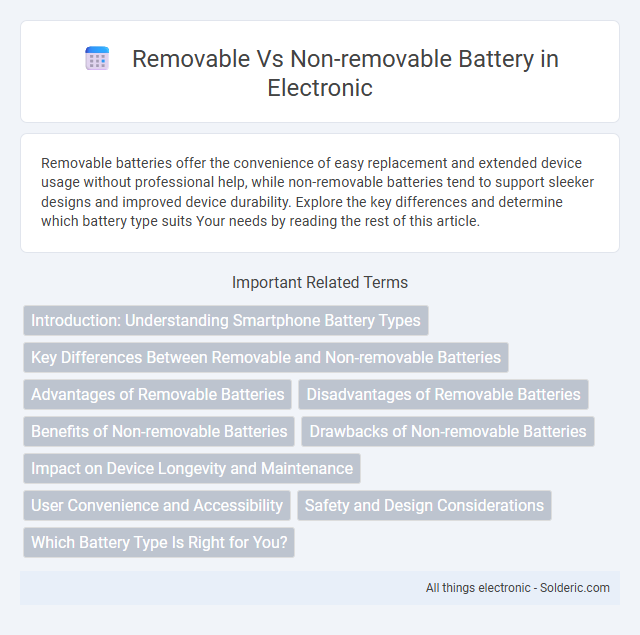Removable batteries offer the convenience of easy replacement and extended device usage without professional help, while non-removable batteries tend to support sleeker designs and improved device durability. Explore the key differences and determine which battery type suits Your needs by reading the rest of this article.
Comparison Table
| Feature | Removable Battery | Non-removable Battery |
|---|---|---|
| Definition | Battery can be easily detached and replaced by the user. | Battery is fixed inside the device and not user-replaceable. |
| Replacement | User can replace the battery independently. | Requires professional service or manufacturer assistance. |
| Device Design | Allows simpler, often thicker device design. | Enables sleeker, compact, and waterproof designs. |
| Battery Life Management | User can swap batteries to extend usage time. | Relies on internal battery health and charging practices. |
| Durability | Potentially less sealed, prone to dust and moisture. | Better sealing, improved dust and water resistance. |
| Cost | Potentially cheaper repairs due to easy replacement. | Higher repair cost due to complex battery replacement. |
| Examples | Older smartphones, some laptops, portable devices. | Modern smartphones, tablets, ultrabooks. |
Introduction: Understanding Smartphone Battery Types
Smartphone batteries are primarily categorized into removable and non-removable types, each offering distinct advantages for users. Removable batteries allow easy replacement and quick swaps, enhancing device longevity and convenience during power outages. Non-removable batteries, commonly lithium-ion or lithium-polymer, support sleek designs and improved water resistance but require professional service for replacement.
Key Differences Between Removable and Non-removable Batteries
Removable batteries allow you to easily replace or swap out your device's power source, enhancing convenience and extending device lifespan. Non-removable batteries are integrated into the device, offering a sleeker design and improved water resistance but requiring professional service for replacement. Your choice depends on whether you prioritize user-friendly battery changes or a compact, durable device construction.
Advantages of Removable Batteries
Removable batteries offer the advantage of easy replacement, enabling users to swap out depleted power sources instantly without specialized tools or professional service. This feature extends device lifespan and reduces downtime, as carrying spare batteries allows continuous use during travel or extended activities. Removable batteries also facilitate better battery health management, as users can replace aging cells promptly, maintaining consistent device performance.
Disadvantages of Removable Batteries
Removable batteries often suffer from reduced durability and increased risk of degradation due to frequent handling and improper installation. These batteries also tend to be bulkier, leading to less sleek device designs and potential loss of internal space for other components. Furthermore, removable batteries pose a higher risk of accidental damage and connectivity issues compared to integrated, non-removable battery systems.
Benefits of Non-removable Batteries
Non-removable batteries offer advantages such as a sleeker device design and improved structural integrity, allowing manufacturers to create thinner and lighter electronics. These batteries tend to have better safety features with fewer risks of exposure to dust or moisture, enhancing overall device durability. Your device benefits from longer-lasting performance due to optimized battery placement and advanced battery management systems integrated within non-removable units.
Drawbacks of Non-removable Batteries
Non-removable batteries limit user flexibility, making device repairs and replacements costly and challenging, often requiring professional service. These batteries can degrade over time, reducing device lifespan and performance without an easy way for users to replace them. Furthermore, non-removable designs contribute to increased electronic waste since devices are more likely to be discarded instead of repaired.
Impact on Device Longevity and Maintenance
Removable batteries allow easy replacement, extending your device's overall longevity by enabling battery swaps once capacity degrades. Non-removable batteries, often integrated into the device, can contribute to a sleeker design but may require professional service for replacement, potentially increasing maintenance costs. Optimal device lifespan depends on how battery type influences ease of repair and sustained performance.
User Convenience and Accessibility
Removable batteries offer greater user convenience by allowing you to quickly replace a depleted battery without needing technical assistance, extending device uptime and simplifying troubleshooting. Non-removable batteries, commonly found in modern smartphones, provide a sleeker design and improved water resistance but require professional service for replacement, potentially leading to longer downtime. Accessibility for users to manage power issues independently is higher with removable batteries, enhancing overall device usability.
Safety and Design Considerations
Removable batteries offer the advantage of easy replacement and reduced risk of device damage during battery removal but may compromise the device's structural integrity and increase exposure to contaminants. Non-removable batteries enhance safety by minimizing user interference, reducing the risk of improper installation or battery swelling, and allowing for more compact, sleek device designs. Your choice between removable and non-removable batteries should balance safety concerns with design preferences, considering factors like durability, repairability, and overall device aesthetics.
Which Battery Type Is Right for You?
Choosing between a removable and non-removable battery depends on your preferences for convenience and device longevity. Removable batteries allow easy replacement and extended usage without professional help, ideal for users who prioritize quick swaps and backups. Non-removable batteries offer a sleek design and better device integrity but may require professional service when your battery's health declines, making them suitable for those valuing aesthetics and durability.
Removable vs Non-removable battery Infographic

 solderic.com
solderic.com